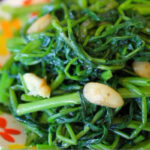Choosing Fresh Vegetables: The key to keeping your veggies crisp and vibrant is to select the freshest produce. Ideally, choose vegetables that have just been harvested, ensuring they retain their vibrant green color.
Remember, fresh vegetables boast the best flavor, texture, and nutritional value. They also stay greener when stir-fried.
If you opt for wilted vegetables, they won’t crisp up, and their color will turn dull and unappetizing after cooking.
Preparing the Vegetables: Once you’ve selected the freshest veggies, it’s time to sort and soak them. Soaking vegetables in salted water prevents oxidation and minimizes nutrient loss, including trace elements. Vegetables are rich in chlorophyll, which can turn black when oxidized.

Blanching the Vegetables: Before you stir-fry, it’s crucial to blanch your greens. Many green vegetables contain oxalic acid, so blanching is a necessary step before consumption. Bring a pot of water to a boil, add a pinch of salt, and then directly add the greens once the water boils. Blanch for 20 seconds and then remove the vegetables immediately. Avoid over-blanching, as this will deplete the vegetables of their vitamins.
Stir-Frying: The golden rule for stir-frying veggies is to do it for 3 minutes over high heat.
Heat your wok over the highest flame setting. To test if it’s hot enough, sprinkle a few drops of water into the wok. If the water evaporates within 1-2 seconds of contact, your wok is ready. Be careful not to overheat it.
Move the wok away from the heat and add oil: Take the wok off the heat and add a spoonful of oil. Lift the wok and tilt it to coat the bottom and sides with oil. (If the oil smokes excessively when added, it means your wok is too hot. Remove it from the heat and let it cool for a few minutes.)
Add garlic and chili (if using) and sauté for 10 seconds or until fragrant.

Add vegetables: Push the garlic to the side of the wok and add your vegetables.
Season the vegetables: Sprinkle salt and pepper over the veggies.
Stir-fry for 1 minute: Fry for 1 minute or until the vegetables start to wilt.
Add the sauce: Pour the sauce around the edges of the wok, rather than directly into the center, to avoid reducing the wok’s temperature. Stir-fry and toss to coat the vegetables in the sauce.
Only stir-fry a handful of vegetables at a time, ensuring they fit comfortably in your wok. Overcrowding the wok will make it difficult to stir-fry evenly, resulting in uneven cooking and unappetizing colors.
Source: Khoevadep
The Ultimate Guide to Unlocking the Secrets of the Keyhole: What’s the Purpose of that Tiny Hole?
The small hole alongside the keyhole on a padlock serves a significant purpose. It is not merely an aesthetic feature but a functional one, integral to the operation and maintenance of the lock. This subtle detail often goes unnoticed, yet it plays a pivotal role in the overall functionality and longevity of the locking mechanism.
Is It Okay to Use Meat Broth for Boiling Vegetables?
“Should You Use Meat Broth to Boil Vegetables?”
There’s a constant debate on whether it’s a good idea to use meat broth for boiling vegetables. While some advocate for this method as a time-saver that preserves nutrients, others question the potential impact on taste and health. So, what’s the verdict? Is it a convenient, nutritious option, or does it compromise the integrity of your veggies?
“Should You Boil or Stir-Fry Your Veggies? 5 Veggies You Should Never Boil and Why”
“Are you aware of the nutritional differences between stir-frying and boiling your vegetables? It’s time to uncover the truth and discover which cooking method retains the most nutrients. This article will delve into the science behind these two popular cooking techniques and provide insights into how you can maximize the nutritional value of your meals. It’s an eye-opening exploration that will change the way you cook forever.”






































